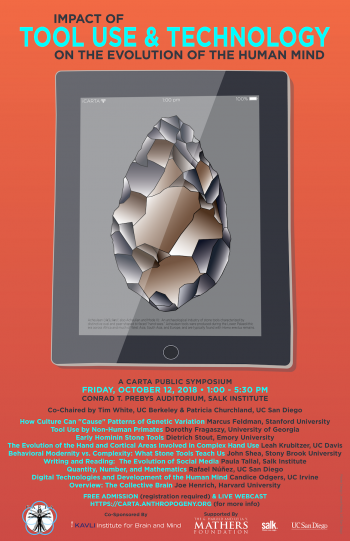Impact of Tool Use and Technology on the Evolution of the Human Mind
Tim White, University of California, Berkeley
Patricia Churchland, University of California, San Diego
Co-sponsored by the Center for Academic Research and Training in Anthropogeny (CARTA) and the Kavli Institute for Brain and Mind (KIBM)
We “behaviorally modern humans” likely emerged more than 100,000 years ago in Africa, spread across that continent and eventually all over the planet, effectively replacing all closely related potentially competitive species. Among many possible explanations, one key to our consistent success in such replacement was the ongoing interactive gene-culture co-evolution of the human brain mind with tool use and technology that began much earlier––ranging all the way from simple stone tools millions of years ago, to computers today. This symposium will address this important gene-culture co-evolutionary process in anthropogeny at all levels, ranging from molecules to brain imaging––beginning with the potential link between early stone tool use and the parallel expansion of the human brain, to the control of fire and the invention of projectile weapons, all the way through reading and writing to current day technologies such as computers and 3D reality––perhaps with a look to the potential future of the human mind, under the impact of continually evolving culture. Appropriate comparisons with other living and extinct species would be included, as will attention to other relevant cognitive features unusually well-developed in humans, such as language, theory of mind and cooperation. An underlying question relevant to anthropogeny was first posed by Wallace: how did the human mind originally evolve such remarkable capabilities in Africa, “in advance of its needs”? After all, even today no human is born with the genetic capability to make even simple stone tools?
Media for each talk can be played by clicking on icons in the table below, or by clicking on the individual talk titles below and then the attachment file at the bottom of the page.
| Speakers | Media | Session |
|---|---|---|
 Ajit Varki  Tim White |
|
Welcome & Opening Remarks |
 Marcus Feldman |
|
Culture, Demography and Patterns of Human Genetic Diversity Advances in DNA genotyping and sequencing technology have led to an upsurge in studies of “polygenic” influences on many human behavioral traits. In this talk, I will discuss how human cultural norms and preferences have affected, and continue to affect, patterns of genomic variation in different populations. Examples include studies of ancient and modern populations, with genetic variation obtained from the Y-chromosome and the other 22 pairs of human chromosomes. |
 Dorothy Fragaszy |
|
Tool Use by Non-Human Primates Humans have used tools since the dawn of our species. Evidence is accumulating that extinct hominins also used stones as tools, apparently in ways similar to how a few species of primates in South America, Africa, and Asia use them: as hammers to open encased foods. Nonhuman primates, compared to humans, use simpler objects as tools and use tools in simpler ways. Unlike humans, no nonhuman primate is an obligate tool user. Individuals neither teach others nor learn via imitation to use tools. ... read more |
 Dietrich Stout |
|
Early Hominin Stone Tools The simple fact of tool-making no longer provides a sharp dividing line between “Man the Tool-Maker” and the rest of the animal world. It is now clear that many other species make and use tools, and that distinctly human technology emerged through a long and meandering evolutionary process rather than the crossing of some critical threshold. However, it would be a mistake to underestimate the transformative effects of tools on everything from our hands and brains to our reproductive strategies... read more |
 Leah Krubitzer |
|
The Combinatorial Creature: Cortical Phenotypes Within and Across Lifetimes The neocortex is one of the most distinctive structures of the mammalian brain, yet also one of the most varied in terms of both size and organization. Multiple processes have contributed to this variability including evolutionary mechanisms (i.e.,alterations in gene sequence) that alter the size, organization and connections of neocortex, and activity dependent mechanisms that can also modify these same features. Thus, changes to the neocortex can occur over different time-scales, including... read more |
 John Shea |
|
Behavioral Modernity vs. Complexity: What Stone Tools Teach Us European paleoanthropologists developed the behavioral modernity metaphor in the 1970s, when it became clear that the archaeological record for human origins in Europe 45,000 years ago differed from that found with older “archaic” humans in Africa and Asia. Since then, archaeologists have defined behavioral modernity strategically, varying diagnostic criteria to draw attention to one or another kind of evidence. Many have cited the use of projectile weaponry as evidence for modern human... read more |
 Paula Tallal |
|
Writing and Reading: The Evolution of Social Media Language co-evolved with the human brain throughout the evolution of Homo sapiens. Writing, on the other hand, is a relatively new technology that was invented by humans to translate spoken language into a visual form for transmitting verbal communication broadly to many people over large distances and time. As such, writing and reading can be considered the first 'social media' technology. Written language co-opted the brain substrates that evolved for spoken language. While language develops... read more |
 Rafael Núñez |
|
Quantity, Number, and Mathematics Mathematics is one of the most sophisticated, precise, and abstract conceptual edifices humankind has ever created, supporting science, technology, economics, and deep philosophical investigations. Yet, mathematics is a remarkably recent invention in the history of Homo sapiens. What made it possible? One fundamental building block is “number,” whose simplest forms, conventional wisdom holds, are said to be biologically endowed and shared by many species. What is shared, however, are general... read more |
 Candice Odgers |
|
Digital Technologies and the Development of the Human Mind Adolescents spend an average of 6 to 8 hours online and in front of screens each day for non-school related tasks. Globally, one in three internet users worldwide are under the age of 18. Yet the online world and complex machine learning algorithms that drive and direct young people’s experiences have not been constructed with their needs in mind. Using streaming information from mobile phones and wearable devices, Odgers shares new data describing how digital technology use relates to... read more |
 Joseph Henrich |
|
The Collective Brain Long before the origins of agriculture or the rise of the first cities, our species spread out across the globe into an immense diversity of environments, from the frozen tundra of Siberia to the arid deserts of Australia. Our species’ immense ecological success in these environments depended not on our vaulted intelligence or rationality, or on any array of local genetic adaptations as in other species. Instead, human survival and success depends on the inheritance of large bodies of... read more |
 All Speakers  Pascal Gagneux |
|
Wrap-up, Question and Answer Session, Closing Remarks |
| Attachment | Size |
|---|---|
| 361.06 KB | |
| 759.31 KB | |
| 160.11 KB | |
| 1011.22 KB | |
| 841.57 KB |
If you enjoy this event, please consider supporting CARTA's quest to explore and explain the human phenomenon.


